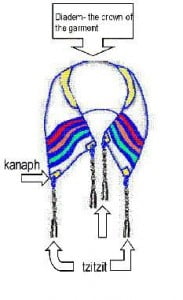Download the Notes: Healing Hem - The wings of God
| Contents | Pages |
| Introduction and use of the Tallit | 1-2 |
| Samuel, Saul and David | 3 |
| Ruth and Boaz | 4 |
| Elijah and Elisha | 4 |
| Touching the hem of Messiah | 5 |
While in Israel, I bought a Tallit. The tallit (also pronounced tallis) is a prayer shawl, the most authentic Jewish garment. It is a rectangular-shaped piece of linen or wool (and sometimes, now, polyester or silk) with special fringes called Tzitzit on each of the four corners. The purpose of the garment is to hold the Tzitzit and acts as a head covering for prayer. “Tallit” simply means gown or cloak, reflecting the fact that it was originally worn throughout the day. It probably resembled the abbayah (blanket) still worn by Bedouins.
The word tallit isn’t originally Hebrew and does not appear in the Bible; rather, other words meaning robe or garment are paired with words meaning tassel or fringe to indicate the proper attire.
Many rabbinic authorities, however, favor a simple tallit of pure white wool as the classic biblical garment, basing themselves on the verse “let your garments always be white” (Ecclesiastes 9:8).5 The tzitzit (threads or fringes) attached to each corner are traditionally made of the same fabric as the tallit; however, wool fringes are always permissible.
These tassels in Hebrew is called “tzitzit” (singular) pronounced “seet-seet.” In the King James Version of the Bible they are translated as “fringe” or “fringes.” These fringes are attached to the “borders” or “corners” of their garments, or tallit.
The KJV translates the Hebrew word “kanaph” as “borders” in Numbers 15:38. According to the Brown-Driver-Briggs’ Hebrew dictionary the Hebrew word “Kanaph” means:
1) wing, extremity, edge, winged, border, corner, shirt
1a) wing 1b) extremity 1b1) skirt, corner (of garment)
 Hem: Greek: kraspedon (GSN-2899), a tassel of twisted wool (Matthew 9:20; Matthew 14:36; Matthew 23:5; Mark 6:56; Luke 8:44). This word in the Greek language means latterly fringes. The woman was reaching for the fringes of His Garment. The Hebrew word is: “tsiytsith”. It was required to be on the four corners of the clothing of every Jewish male in accordance with God’s instructions.
Hem: Greek: kraspedon (GSN-2899), a tassel of twisted wool (Matthew 9:20; Matthew 14:36; Matthew 23:5; Mark 6:56; Luke 8:44). This word in the Greek language means latterly fringes. The woman was reaching for the fringes of His Garment. The Hebrew word is: “tsiytsith”. It was required to be on the four corners of the clothing of every Jewish male in accordance with God’s instructions.
The earliest mention of Kanaph is found in Exodus 19:4 : “Ye have seen what I did unto the Egyptians, and how I bare you on eagles’ wings (kanaph), and brought you unto myself.”
Many Bible teachers have stated that the first use of a word sets the stage for the underlying meaning of the word throughout the remainder of the Scriptures.They call this the “law of first reference.” Here we can concur that through the “kanaph” there is deliverance. The children of Israel were delivered or set free from the Egyptians because God bare them on eagles’ kanaph, and brought them unto Himself.
The wearing of the “tallit” (pronounced tal-eet), also called the “tallis” or “prayer shawl,” was commanded by God.